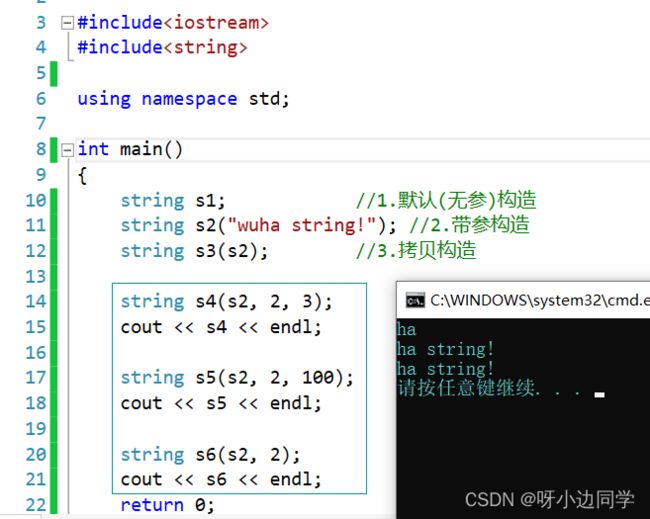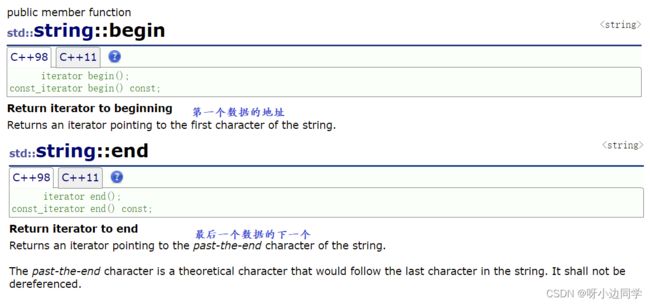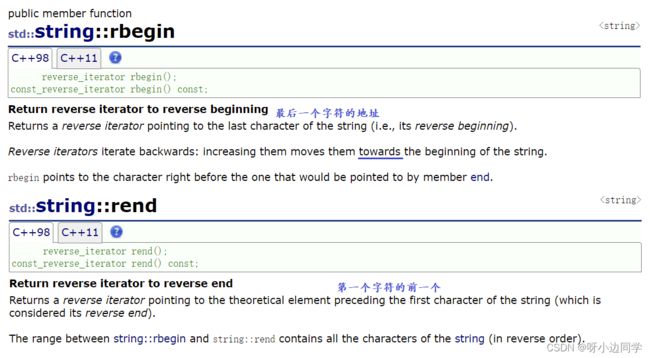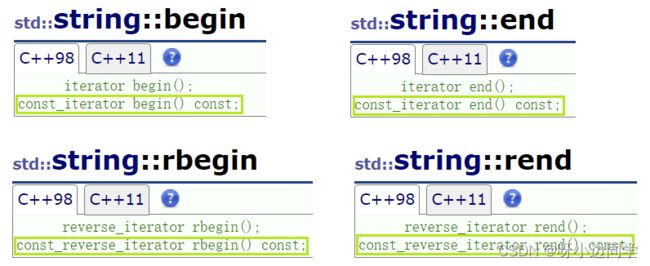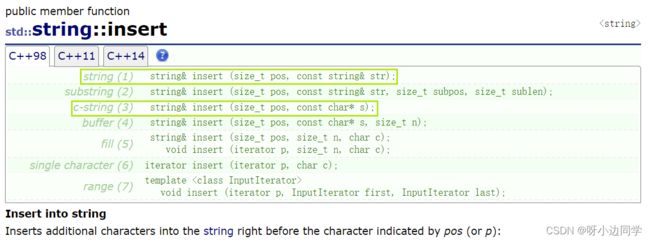【C++】string类@STL
string类
- 0. string类
- 1. 构造&析构&赋值重载
- 2. Capacity 容量操作
-
- 2.1 size vs length
- 2.2 capacity
- 2.3 resize vs reverse
- 2.5 clear
- 2.6 empty
- 3. operator[]
- 4. Iterator 迭代器
-
- 4.1 正向迭代器
- 4.2 反向迭代器
- 4.3 const迭代器
- 4.* 范围for遍历更改
- 5. Modifiers 修改
-
- 5.1 追加
- 5.2 插入 & 删除
- 6. String operations
-
- 6.1 c_str
- 6.2 substr 子串
- 6.3 查找 find & rfind
- 7. Non-member function overloads
-
- 7.1 流插入&流提取
- 7.2 getline
学习STL要勤查阅此网站: cplusplus.com - The C++ Resources Network
正文开始@边通书
0. string类
string类实际上是basic_string这个类模板的实例化 ——
template<class T>
class basic_string
{
// ...
private:
T* _str; //动态申请的
size_t _size;
size_t _capacity;
// ...
};
可能令人疑惑的是,难道字符串类型中不都是字符吗,为什么还要有类模板呢?这就要说到不同的编码规则。
在ascii编码表中,将值和符号建立映射关系,1byte空间可以表示256个英文字符;再说unicode,是为了表示全世界文字的编码表,其中的utf-16方案,所有字符,无论中英还是啥,都是两字节表示(这样计算字符个数很方便,但是能表示字符也受限)。你可以认识的到,字符可不简单的是char,还可以是wchar宽字符等等。
(关于编码,不是这里的重点,话说昨天的CSAPP课上,老师忽然讲起了编码,讲了好久演示了好多,真的很有意思!让我忽然觉得这门课好棒,然而后来他讲起了执行三条汇编指令计算机发生了什么,太tnd底层了,都把我讲磕头了哎哈哈)
下面介绍string类常用的接口❤️ ,要熟练掌握,其余的用时查阅即可。在使用string类时,需要包含头文件#include以及展开命名空间using namespace std;
1. 构造&析构&赋值重载
❤️ 1. 构造函数
其余的接口简单演示,主要为了演示如何查阅文档。
功能:从pos开始取对象的一部分(len)。
substring (3) string (const string& str, size_t pos, size_t len = npos);
其中len给了缺省值npos,npos是string类的一个静态成员变量,值为-1,在补码中就是全1,赋给了无符号数size_t,就是整型的最大值4,294,967,295。因此,如果不传参采用缺省值,那就是有多少取多少。因为这个数字太大了42亿9千万,一个字符串就4G,可能吗?
演示 ——
注:string类对象支持直接用cin和cout进行输入和输出,因为重载了流插入>>和流提取<<操作符(后文详谈)。
取字符串前n个
from sequence (5) string (const char* s, size_t n);
填充初始化
fill (6) string (size_t n, char c);
❤️ 2. 析构函数
自动调用释放资源,不用管了。
❤️ 3. 赋值重载
2. Capacity 容量操作
2.1 size vs length
❤️字符串中有效字符长度,即不包含最后作为结尾标识符的\0
两者底层实现完全一致(length的存在是历史原因),但强烈推荐使用size. 这是为了和后序各种容器接口保持一致(各种容器接口表示多少个数据都用size,没有说你求二叉树的length的吧)
2.2 capacity
❤️ 容量:能存多少个有效字符(注意\0没算),要记得string类的底层是顺序表结构
演示 ——
2.3 resize vs reverse
reserve 和 resize 都是改变容量,申请至少n个字符的空间(字符串涉及对齐问题,后续详谈) ,但有所不同 ——
❤️ 1. resize - 开空间,并可以对空间初始化
-
如果是将元素个数减少,会把多出
size的字符抹去,这很符合resize这个函数的名字 -
如果是将元素个数增多,
void resize (size_t n);用\0来填充多出的元素空间,void resize (size_t n, char c);用字符c来填充多出的元素空间 -
注:resize在改变元素个数时,如果是将元素个数增多,可能会改变容量的大小;如果是将元素个数size减少,容量不变。
调试可见 ——
#include❤️ 2. reserve - 开空间。在已知需要多少空间时,调用reserve,可以避免频繁增容的消耗。
-
为字符串预留空间,改变容量。当然了不会改变有效元素个数size。
-
当给reserve的参数n小于string的容量时,是无效请求,并不会改变容量大小。
调试可见 ——
#include2.5 clear
2.6 empty
3. operator[]
❤️ 重载了[],使得string类可以像数组一样访问字符。不同的是,数组访问本质是解引用,而这里是调用函数。
它提供了两个版本 ——
❤️ operator[]返回的是每个字符的引用,这使得它可读可写。
引用,可以减少拷贝,但这里并不是。这里是做输出型参数,是为了支持修改返回对象。
1. 【遍历 + 修改】方法一 ——
#include注意:下面这两个函数功能一致(at的存在还是历史原因),只不过二者检查越界的方式不同,推荐使用[] ——
4. Iterator 迭代器
本节将介绍第二种【遍历 + 修改】的方式:迭代器。迭代器是STL的六大组件之一,用来访问和修改这些数据结构。
看完本节你可能有这样的疑惑,对于string类,无论正着还是倒着走,[下标]的方法都足够好用,为什么还要有迭代器?
事实上,迭代器是一种通用的遍历方式,所有容器都可以使用迭代器这种方式去访问修改,而list、map/set不支持[下标]遍历。结论是,对于string类,我们得会用迭代器,但是我们更喜欢用[下标]。
4.1 正向迭代器
正向迭代器提供了两个成员函数 ——
❤️ 迭代器是内嵌类型,想象成像指针一样,但又不一定是指针
#include- iterator依然提供了两个版本,第二个是
const成员函数, - 关于
!=可不可以写成<:答案是可以但不建议。对于string类可以,是因为它的物理空间是连续的,其他容器就不一定了。
4.2 反向迭代器
❤️ 倒着遍历字符串 ——
#include4.3 const迭代器
所谓const迭代器,实际上是上面那些成员函数重载的第二个版本。
- 上述的普通迭代器可读可写,实际上调用的是第一个接口(相当于string类模板中,类型为
T*); - 而const迭代器不可写。这是因为是const成员函数,const修饰this指针指向的内容(相当于string类模板中,类型为
const T*)
const迭代器也分正向迭代器和反向迭代器,且就是给const对象用的。这是因为const对象才能调用这里的const成员函数,返回const迭代器,不可写;是普通对象就直接调用普通的重载接口(因为两个重载函数同时存在),返回普通迭代器,可读可写。
它出现的情况往往是这样 ——
#include传参进func中,s是const对象,自动调用第二个接口,返回的是const_iterator,要用const迭代器类型接收,且不能修改。
C++11为了区分const迭代器和普通迭代器还提供了以下接口,不然调用时容易混淆,实际上用的不多。
4.* 范围for遍历更改
顺便介绍【遍历 + 更改】的第三种,范围for是C++11提供的语法糖,实际上底层编译器也会替换成迭代器。
把s中的每个字符取出来,赋值给e
- 自动向后迭代
- 自动判断结束
#include注:
- 要修改,auto记得带上引用
&。若s中的每个对象比较大,也最好加& - 范围for也可以不写
auto,直接写类型也可。
5. Modifiers 修改
5.1 追加
❤️ +=更常用,因为既可以追加字符、也可追加字符串 ——
int main()
{
string s("more than words");
s.append(" is all you have to do to make it real");
s.push_back('~');
cout << s << endl;
s += "then you wouldn't have to say that you love me, cause I'd already know";
s += "~";
cout << s << endl;
return 0;
}
❤️ 下面来探究尾插扩容容量变化 ——
#include可以看到在vs下,第一次是2倍,后面是约等于1.5倍的增容 ——
注:在知道需要是多少空间,可以调用reserve预留空间,避免频繁增容的消耗。
5.2 插入 & 删除
尽量少用头部和中间的插入删除,因为要挪动数据,O(N)效率低。
6. String operations
6.1 c_str
❤️ 返回C格式字符串
打印字符串,都能打印,但意义不同 ——
前者是string类的流插入运算符的重载,size是多少打印多少;后者是按字符串类型打印,遇到\0结束。
主要作用还是与函数接口接合,like this——
string file("test.txt");
FILE* fout = fopen(s.c_str(), "w");
6.2 substr 子串
❤️ 取当前串的一个子串
len:如果len比能取到的串长或使用缺省值npos,都是能取多少取多少。
6.3 查找 find & rfind
❤️ 1. 从字符串pos位置从前向后找字符c/字符串,返回该字符在字符串中的位置
❤️ 2. 从字符串pos位置从后向前找字符c/字符串,返回该字符在字符串中的位置
现在我要取file的后缀名 ——
#include解析出网址的这三个部分:协议 - 域名 - 资源
#include7. Non-member function overloads
7.1 流插入&流提取
注意,流插入和流提取都是以空格、回车作为结束标志的。这意味着如果想要输入一个字符串,最终可能只读入了一个单词。
于是我们引入getline.题目中就会遇到。
7.2 getline
持续更新~@边通书





